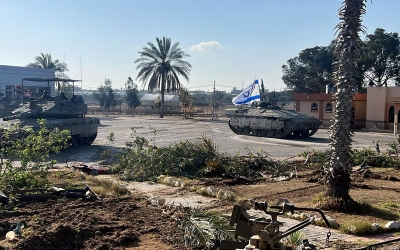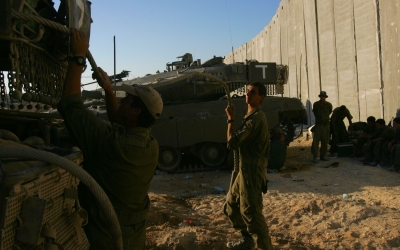Israeli capture of the Palestinian side of the Rafah crossing in southern Gaza further endangered the already bleak humanitarian and medical situation in the enclave.
Israel’s 401st Armoured Brigade took control of the crossing in southern Gaza on Tuesday morning, after another brigade disconnected Salah al-Din road in eastern Rafah from the crossing overnight.
The Israeli flag was raised on flag poles at the crossing, while the Palestinian flag was pulled to the ground.
The Rafah crossing is a vital lifeline for Palestinians, as the only gateway in and out of the enclave not directly controlled by Israel. Since Hamas took control of the territory in 2007, the crossing has been jointly administered by Egypt and Hamas.
The Israeli military said the Karem Abu Salem (Kerem Shalom) crossing along the boundary between Gaza, Israel and Egypt, which Israeli authorities control, had also been closed for security reasons.
The ground operation comes after several days of heavy bombardment of Rafah, where over 1 million displaced Palestinians are sheltering in tents and makeshift homes.
Middle East Eye takes a look at how the ground invasion into eastern Rafah and areas along the boundary with Egypt will impact Palestinians.
Devastating impact
The Palestinian health ministry said that all operations at the crossing were halted due to Israel capturing the gateway.
“The wounded, sick and their relatives were prevented from travelling to receive treatment outside Gaza,” the ministry said in a statement on Tuesday.
‘The closure of the Rafah crossing effectively means the only viable lifeline for aid workers is cut’
– Ahmed Bayram, Norwegian Refugee Council
“We have travel lists for thousands of cases of wounded and sick, and now they have been prevented.”
It called on the countries who had requested lists of wounded and sick Palestinians to “fulfil and adhere to their pledges” by working urgently to secure their safe exit from Gaza.
According to the Palestinian ambassador in Cairo, Diab Allouh, an estimated 80,000-100,000 Palestinians have fled Gaza via Egypt since the war began.
Analysis by MEE found that in April, an average of around 450 Palestinians were leaving Gaza via the Rafah crossing each day. The numbers could be much higher when including foreign nationals leaving the enclave.
The effective closure of the Rafah crossing will also have a devastating impact on aid deliveries into Gaza.
Aid trucks carrying medicine, medical equipment and fuel needed for hospitals were prevented from entering the enclave on Tuesday, the health ministry said.
Jens Laerke, the UN humanitarian office’s spokesperson, said: “The two main arteries for getting aid into Gaza are currently choked off,” referring to the Rafah and Karem Abu Salem crossings.
“If no fuel comes in for a prolonged period of time it would be a very effective way of putting the humanitarian operation in its grave.”
Ahmed Bayram, of the Norwegian Refugee Council, told MEE that the entire aid infrastructure in Gaza “teeters on the brink of collapse”.
“The closure of the Rafah crossing effectively means the only viable lifeline for aid workers is cut.
“The NRC operates in Rafah, relying on the crossing to deliver crucial aid. With fuel reserves dwindling and unable to meet escalating demand, a catastrophe seems inevitable unless Israel reverses its course of action.”
Some non-fuel supplies have entered the enclave in recent days via the Israeli-controlled Beit Hanoun (Erez) crossing in northern Gaza, which is mostly used for foot traffic rather than goods.
“Erez will simply not be enough,” said James Elder, spokesperson for the UN children’s agency. “If Rafah gate closes for an extended period, it’s hard to see how famine in Gaza can be averted.”
In the genocide case against Israel, the International Court of Justice in January issued a provisional ruling ordering the country to enable the entry of urgent humanitarian aid into Gaza.
But well before the capture of the Rafah crossing, Israel had already been found to be defying the order by directly bombing aid convoys and impeding aid deliveries through delays and denials of entry.
Hospitals overwhelmed
On Monday, Israel dropped leaflets over Rafah ordering the ejection of up to 250,000 Palestinians in eastern areas of the city.
It said the military was “about to operate with force against the terror organisations in the area”.
Heavy bombardment of Rafah coupled with the disconnection of Salah al-Din road will have a major impact on the operations of aid organisations.
“My colleagues were woken up at dawn by the sounds of air strikes and artillery fire,” said Bayram. “This is the closest attacks have come to the centre of aid work in Rafah and it will mark a new, dangerous phase.”
Civilians in the areas warned by Israeli authorities have been told to flee to al-Mawasi, a small area that’s just 1km wide and 14km long.
“This narrow strip of land, ill-prepared to host hundreds, let alone hundreds of thousands, has no spots left for people to pitch their tents or spend the next period,” said Bayram.
Palestinians sheltering in Rafah told MEE on Monday that there was a lack of clarity from Israeli authorities about how quickly they should leave and when they would be able to return.
There was also uncertainty about the fate of the Abu Yousef Al Najjar Hospital, one of only two medical facilities currently serving the Rafah governorate.
Najjar Hospital falls within the area that Israel has ordered civilians to leave.
The other facility in Rafah, Kuwait hospital, has taken in large numbers of wounded Palestinians on Tuesday. But it was unable to take in patients already at Najjar due to it being in the Israeli military’s red zone.
Suhaib Al-Hams, director of the hospital, told Wafa news agency the facility was overwhelmed with critically wounded patients, but did not have sufficient food, beds, equipment or fuel to continue operating much longer.
Hams said the only X-ray machine had stopped working due to overuse.
Post Disclaimer
Disclaimer: Rafah invasion: How Israeli control of crossing will cut vital aid lifeline to Palestinians - Views expressed by writers in this section are their own and do not necessarily reflect Latheefarook.com point-of-view

